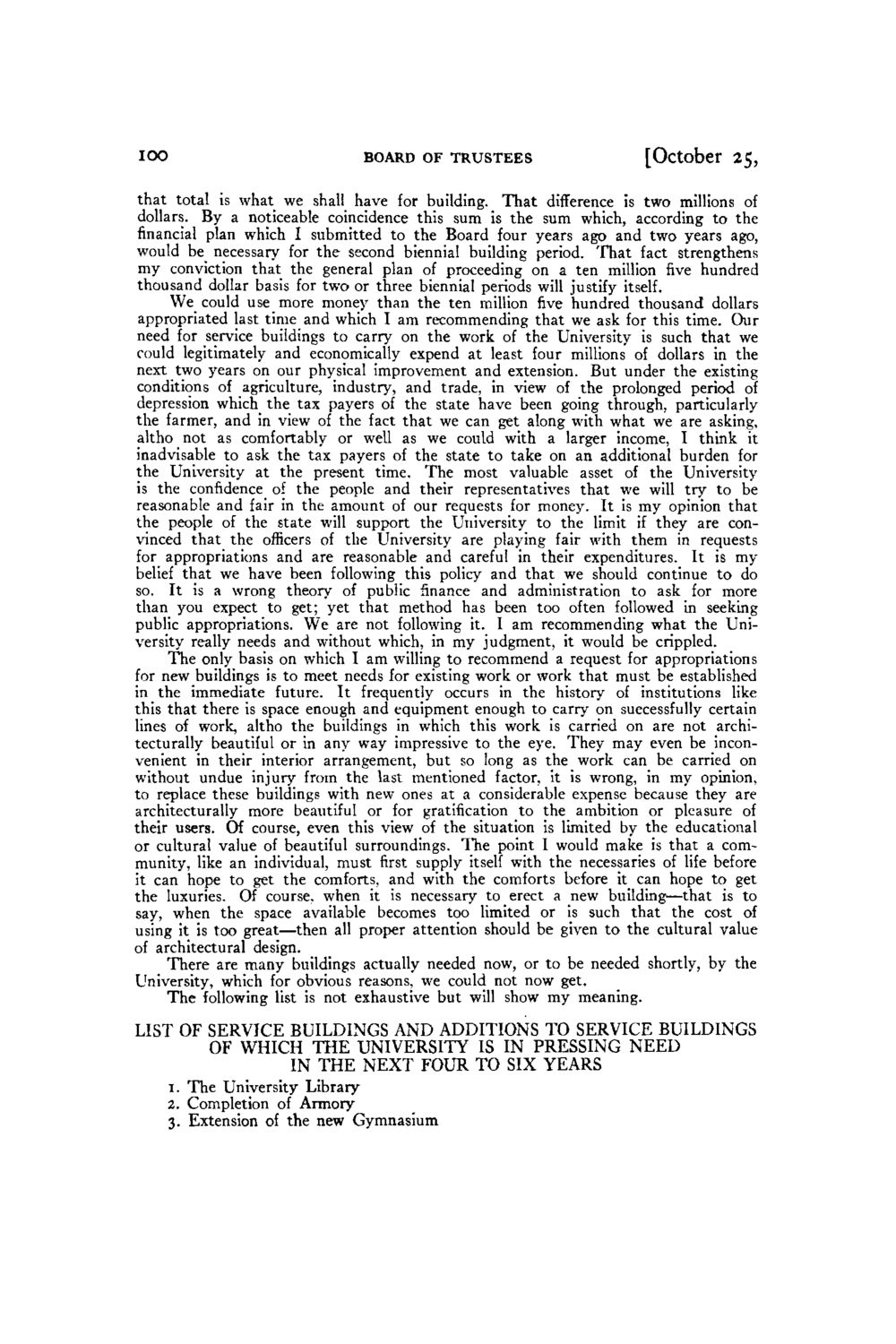| |
| |
Caption: Board of Trustees Minutes - 1926
This is a reduced-resolution page image for fast online browsing.

EXTRACTED TEXT FROM PAGE:
ioo board of trustees [October 2 5 , that total is what we shall have for building. That difference is two millions of dollars. B y a noticeable coincidence this sum is the sum which, according to the financial plan which I submitted to the Board four years ago and two years ago, would be necessary for the second biennial building period. That fact strengthens m y conviction that the general plan of proceeding on a ten million five hundred thousand dollar basis for two or three biennial periods will justify itself. W e could use more money than the ten million five hundred thousand dollars appropriated last time and which I a m recommending that we ask for this time. Our need for service buildings to carry on the work of the University is such that we could legitimately and economically expend at least four millions of dollars in the next two years on our physical improvement and extension. But under the existing conditions of agriculture, industry, and trade, in view of the prolonged period of depression which the tax payers of the state have been going through, particularly the farmer, and in view of the fact that w e can get along with what w e are asking, altho not as comfortably or well as w e could with a larger income, I think it inadvisable to ask the tax payers of the state to take on an additional burden for the University at the present time. T h e most valuable asset of the University is the confidence of the people and their representatives that w e will try to be reasonable and fair in the amount of our requests for money. It is m y opinion that the people of the state will support the University to the limit if they are convinced that the officers of the University are playing fair with them in requests for appropriations and are reasonable and careful in their expenditures. It is m y belief that w e have been following this policy and that w e should continue to do so. It is a wrong theory of public finance and administration to ask for more than you expect to get; yet that method has been too often followed in seeking public appropriations. W e are not following it. I a m recommending what the University really needs and without which, in m y judgment, it would be crippled. The only basis on which I a m willing to recommend a request for appropriations for new buildings is to meet needs for existing work or work that must be established in the immediate future. It frequently occurs in the history of institutions like this that there is space enough and equipment enough to carry on successfully certain lines of work, altho the buildings in which this work is carried on are not architecturally beautiful or in any way impressive to the eye. They m a y even be inconvenient in their interior arrangement, but so long as the work can be carried on without undue injury from the last mentioned factor, it is wrong, in m y opinion, to replace these buildings with new ones at a considerable expense because they are architecturally more beautiful or for gratification to the ambition or pleasure of their users. Of course, even this view of the situation is limited by the educational or cultural value of beautiful surroundings. T h e point I would make is that a community, like an individual, mustfirstsupply itself with the necessaries of life before it can hope to get the comforts, and with the comforts before it can hope to get the luxuries. Of course, when it is necessary to erect a new building—that is to say, when the space available becomes too limited or is such that the cost of using it is too great—then all proper attention should be given to the cultural value of architectural design. There are m a n y buildings actually needed now, or to be needed shortly, by the University, which for obvious reasons, we could not now get. The following list is not exhaustive but will show m y meaning. LIST OF SERVICE BUILDINGS AND ADDITIONS TO SERVICE BUILDINGS OF W H I C H T H E UNIVERSITY IS IN PRESSING N E E D IN T H E N E X T F O U R T O SIX YEARS 1. The University Library 2. Completion of Armory 3. Extension of the new Gymnasium
| |